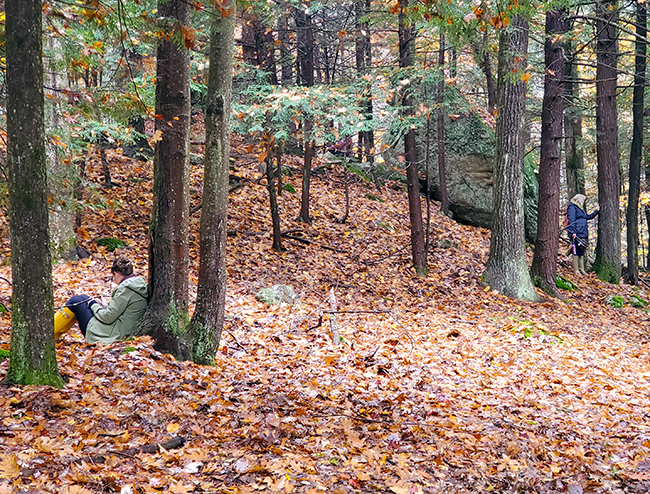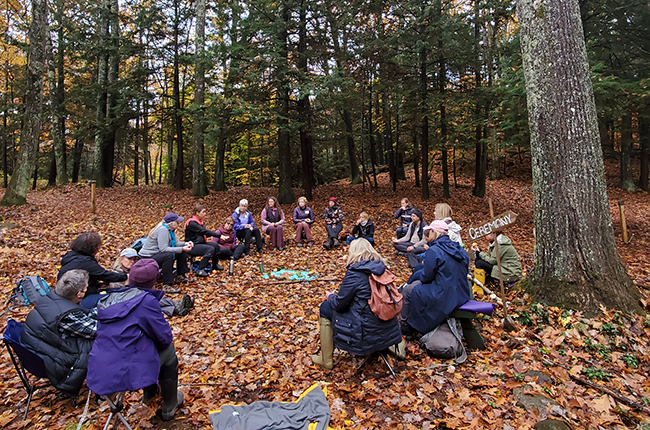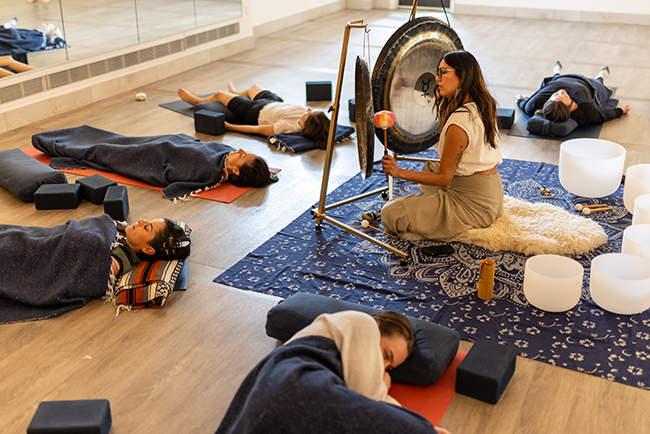Shinrin-Yoku, Colorado-Style
05 Aug 2025
Shinrin-Yoku, Colorado-Style
Blending Japanese tradition with Rocky Mountain terrain, forest bathing takes root in Boulder’s mindfulness movement
By Holly Bowers

You might say it’s a truth universally acknowledged: time in nature is good for us. Often, however, our time outside is about what we can get from nature, whether it’s a beautiful view or another summit bagged. At best, nature serves as a backdrop. At worst, we’re imposing on the landscape.
Forest bathing invites us to reframe that approach, to transition from time in nature to time with nature. M. Amos Clifford, founder of the Association of Nature and Forest Therapy Guides and Programs (ANFT), and author of “Your Guide to Forest Bathing,” wrote: “The destination in forest bathing is ‘here,’ not ‘there.’”
Forest bathing is not, as the name suggests, anything to do with swimsuits. Instead, it’s an intentional slowing down to sit with nature and engage your senses. It comes from the practice of shinrin-yoku, which emerged in the 1980s as a Japanese health initiative.
Darlene Rooney-Keller, a forest immersion guide in Longmont, compares forest bathing to mindful eating. You consciously slow down and focus on your sensory body—what is it like to notice the colors? The feel of the sun on your skin? The sounds that you’re hearing?
On the forest bathing walks she leads, Rooney-Keller offers attendees a series of simple invitations designed to help them connect with their sensory bodies. She might offer up breathing exercises or ask people to notice what they see moving around them. Ultimately, the invitations are open—she recalls one woman who lay on the grass for the entire three hours. “I think people feel grateful to have a space where nothing’s expected of them,” she says.
David Ford, education and outreach program manager with the City of Boulder Open Space & Mountain Parks (OSMP), notes that setting an intention is important. If you’re going on a sunset walk, for instance, maybe think about what you want to sunset in your life.
Scientists have studied the physiological benefits of forest bathing since the 1990s. The practice engages the parasympathetic nervous system, which can reduce stress, lower blood pressure and improve sleep quality. Forest bathers are also exposed to phytoncides, active compounds released by trees. We experience phytoncides as “forest smell,” but they also have proven health benefits. Some preliminary studies have shown that not only do phytoncides lower blood pressure, heart rate and cortisol levels, but they can also increase the activity of natural killer cells, which play a crucial role in fighting off infections and potentially cancerous cells.

The effects are so profound that OSMP offers forest bathing-inspired experiences for groups such as cancer survivors, health care workers, people in recovery from addiction and marginalized community members. “It’s a little piece of the puzzle as we continually work toward more inclusive programming and more equitable access to public lands and nature,” Ford explains.
To him, forest bathing provides more than health benefits, however. It’s an opportunity to deepen our connection with ourselves, with each other and, critically, with nature. He distinguishes between power-over statements and interaction-with statements. “Experiences like forest bathing allow people to develop their lessons and learnings from nature, instead of just walking over or shredding trail or doing something conquering,” he says.
Both Ford and Rooney-Keller acknowledge that, while anyone can practice forest bathing solo, going with a guide can deepen the experience. Guides will keep track of time, for example, so that forest bathers can fully focus on the present moment. They offer invitations and ensure everyone gets back on time, which can go a long way toward quelling anxiety for some people.
Each guide has a unique style and format for forest bathing excursions, so Ford recommends trying different experiences to find one that resonates with you. ANFT has trained more than 2,500 guides and can serve as a valuable resource.
If you do go out on your own, understand the guidelines of the land you’re on. Rooney-Keller emphasizes the importance of noticing your impact and what you’re stepping on. Give yourself plenty of time—anywhere from two to six hours—and understand that forest bathing is a practice, not a one-and-done.
For Ford and Rooney-Keller, forest bathing has been transformative. As Ford notes, humans evolved to be in connection with nature. Being attuned to nature means being attuned to our somatic selves. On the other hand, feeling disconnected from our somatic selves can lead to broader feelings of social disconnection. Forest bathing reconnects us to the larger whole.
It’s worth remembering that the oft-quoted Mary Oliver lines, “Tell me, what is it you plan to do with your one wild and precious life?” are actually about watching a grasshopper eat. They’re about slowing down and connecting with nature.
All of OSMP’s nature walks are listed at naturehikes.org, and you can learn about forest immersions with Darlene Rooney-Keller at naturehealsforestbathing.com












